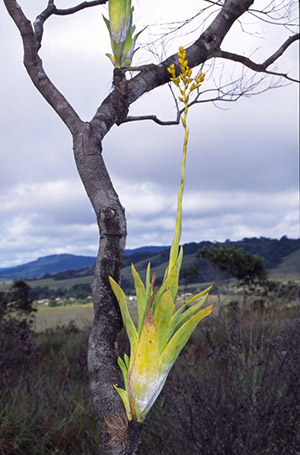
Catopsis berteroniana
Reprinted with permission from Marie Selby Botanical Gardens, Sarasota, FL.
www.selby.org/research/blog/catopsis-berteroniana-bromeliaceae
(See accompanying article by David Troxell in this issue)
January 2014

Catopsis berteroniana
Reprinted with permission from Marie Selby Botanical Gardens, Sarasota, FL.
www.selby.org/research/blog/catopsis-berteroniana-bromeliaceae
(See accompanying article by David Troxell in this issue)
NEWS IN BRIEF . . .
NEW MEMBER:
A very warm welcome to our new members Mary Bennis, June Casey, Teresa Lavalle, Susan Sint Nicolaas, and Christine Stephens who joined at our October meeting and to Val Miller who joined in November. We wish you all a long and happy association with our Society.
POINTS SCORE WINNERS:
Hearty congratulations to our Points Score winners for 2013. Ann Kennon won with the highest points in both the Open and Tillandsia sections and Yvonne Perinotti took home the trophy for the Novice Section. But thanks go to all of our members who participate in our monthly competitions, bringing in their beautiful plants for us to learn from and enjoy.
MONTHLY RAFFLE PRIZE ROSTER:
We will again be using the roster system for providing prizes for our monthly raffles. However, there are a few changes the committee has decided to make this year. Firstly, bromeliads are the preferred option; however, for newer members who may not have a plant to spare, an item to do with the culture of bromeliads is acceptable—for example, gloves, fertiliser, secateurs, etc. Plants other than bromeliads/lemons, etc. will no longer be part of the raffle, but may be brought along as ‘free offerings’. Secondly, in order to cut down on the time spent on the raffle, a maximum of five bromeliads per rostered member (minimum one plant) is requested. If you are unable to attend the meeting—and/or are unable to supply a raffle prize when rostered it would be appreciated if you would either ‘work a swap’ or speak to Suzanne about getting a fill-in for your month. As our membership fees are kept very low, we rely on these raffles to help defray the costs involved in the running of our Society, and so your support is very necessary and very much appreciated.
| Steve Morgan, Meri Stefanidakis, John Toolan, Beth Clague | |
| Jørgen Jakobsen, Nina Rehak, Loreen Whiddett, Val Dixon | |
| Carmel Glanville, Anne-Marie Brun, Maadi McKenna, Maureen Wheeler | |
| Neville Wood, Max Williams, Sandra Southwell, Carole Taylor | |
| Laurie Dorfer, Lydia Chinnock, Eunice Spark, Warwick Varley | |
| Jan Stammers, Noel Kennon, Rena Wainwright, Carol Kerstholt | |
| Yvonne Perinotti, Ted Clare, Freda Kennedy, Monica De Clouett | |
| Beverley Irvine, Ted Whybrow, Eddy Klavins, Phillip Robinson | |
| Glenrae Barker, Jim Beverstock, Stephen Astill, Vicki Joannou | |
| John Carthew, Fred Mirande, Graham Bevan, June Smith, Gloria Purdon | |
| Les Thain, Suzanne Burrows, Colleen Claydon |
WORKSHOPS:
Your committee is planning three workshops this year: The first one is scheduled for Thursday, February 20th at Maureen Wheeler’s home at 4 Lendine Street, Barrack Heights
[Phone: (02) 4243 1778]; the second, on Monday, May 12th, will be arranged by Neville to be held at the Light Rail Museum, 48A Tongarra Road, Albion Park; and the third, dealing with preparing plants for Show, will be held on Saturday, August 9th at Sharyn Baraldi’s home at 25 Antrim Avenue, Warilla
[Phone (02) 4296 2166]. These have been very popular in the past and it is an opportunity for you to bring along any plants that you may be having problems with—or need an identity for—and also to meet and to chat with other members on a friendly, informal basis in a lovely garden/bush setting. The usual hours apply: from 10.00 am until 2.00 pm and anyone interested is invited to attend. Bring your lunch—and something for morning tea would be appreciated—tea and coffee will be supplied.
GARDEN VISITS – SATURDAY, MARCH 15, 2014:
The following members living in the Sutherland Shire area will open up their gardens for members to visit on Saturday, March 15. The plan is to start out at Max Williams’ home at 10.00 am [Phone 9525 5570], followed by Ted and Sylvia Clare’s garden, [Phone 9525 9259] and then on to Edwina Caruana and Steve Wain’s home where Edwina and Steve have kindly offered to supply lunch. In this regard we would need to know how many might be visiting by our March meeting so that they can plan accordingly. After lunch, on the way home, you might like to stop at Eileen Killingley’s in Bundeena in the Royal National Park. (It is not necessary to pay the Park fees if only visiting Bundeena!)
GUEST SPEAKER – MARCH MEETING:
I am very pleased to let you know that Michael Fox, ‘The Frog Man’ has been booked to give a presentation at our March meeting.
REVISED DEFINITION OF ‘NOVICE’ FOR OUR MONTHLY PLANT COMPETITIONS:
In order to clarify the definition of ‘Novice’ as regards our monthly plant competitions, your committee and ‘steering committee’ have provided the following:
“A member may enter plants in the Novice Section providing that:
(i) On January 1st of the current year, the member has been a member of this Society for less than five (5) years; and
(ii) Has not won an Annual Open Points Score Award or an Annual Novice Points Score Award of the Society.
A member who does not satisfy the requirements of either (i) or (ii) may not enter plants in the Novice Section of competition.”
UPCOMING EVENTS :
| HILLS DISTRICT ORCHIDS OPEN DAY (with Dark Star Orchids) 9.00 am – 4.00 pm 183 Windsor Road, NORTHMEAD (next to “The Home Team” - Park in Mary Street.) *Ed - Ian Hook, Pres.BSA, will have an open day on same day - 6 Mary St. Come for a chat. | |
| BROMELIADS AUSTRALIA – OPEN DAY – WYEE – See back page for details. | |
| COLLECTORS’ PLANT FAIR – HAWKESBURY RACE CLUB, CLARENDON Entry $12 Saturday ($10 prepaid) $10 Sunday ($8 prepaid) $12 weekend (prepaid). Under 18s free if with an adult. Speaker Sessions ($33 per person, with Sunday sessions including a light lunch within the cost) and Prepaid Fair Entry. To book: www.collectorsplantfair.com or phone Peta Trehar (02) 4567 2026 | |
| BROMELIAD SOCIETY OF AUSTRALIA – AUTUMN SHOW – BURWOOD RSL | |
| BROMELIAD FAIR – CONCORD SENIOR CITIZENS CENTRE – See back page | |
| WORLD BROMELIAD CONFERENCE - BROMELIADS IN PARADISE – HONOLULU | |
| ILLAWARRA BROMELIAD SOCIETY SPRING SHOW – UNITING CHURCH HALL – Russell Street, CORRIMAL - 9.00 am – 3.30 pm | |
| BROMELIAD SOCIETY OF AUSTRALIA – SPRING SHOW – BURWOOD RSL | |
| 2015 |
BROMSMATTA – 18TH AUSTRALASIAN BROMELIAD CONFERENCE, NOVOTEL, PARRAMATTA. Hosted by The Bromeliad Society of Australia. Early Bird Registration before April 30, 2014 $260 pp. Reg.Form available on www.bromeliad.org.au |
NOVICE
1st = Yvonne Perinotti = Neoregelia ‘Amazing Grace’
2nd = Yvonne Perinotti = Neoregelia
3rd = Lydia and Ian Chinnock = Aechmea
TILLANDSIA
1st = Jørgen Jakobsen = ionantha X stricta
2nd = Ann Kennon = recurvifolia var. subsecundifolia X
3rd = Suzanne Burrows = seleriana
You may have heard of the Venus Fly Trap or the Pitcher Plant, but did you know they are not the only plants that dine on bugs and other small prey? Most bromeliads have unique ways of absorbing nutrients other than through their roots, but there are three particularly special species of bromeliads that get their nutrients from living creatures. Brocchinia hechtioides, Brocchinia reducta and Catopsis berteroniana are the only three bromeliads that are specifically adapted to trapping insects and using them for nourishment.
Most bromeliads already have special adaptations for gathering nutrients. Many have leaves that fuse together to make a rosette shape that holds water in what is called a tank or urn. Trichomes, found on the leaves, take in the water and nutrients that comes from dust, leaves, plant matter and occasionally insects or droppings that fall into the tanks and decompose. While most bromeliads occasionally take in a few insects for nutrients they are not adapted to lure, trap and decompose the insects in the same ways B. hechtioides, B. reducta and C. berteroniana are. While the scientific community has been aware of these species for a long time it wasn’t until the 1980s that these three species were studied closely and observed consistently taking in insects at a much higher rate than other bromeliads, suggesting that they are adapted to survive carnivorously.
Carnivorous Species Characteristics
According to Stewart McPherson, in an article for the Florida Council of Bromeliad Societies, B. hechtioides, B. reducta and C. berteroniana have several adaptations that allow them to attract, trap and break down the insects so that they can be used for energy and growth. The first is their conspicuous colour. All three species are bright yellow and their rosette-shaped leaves appear similar to flowers. This feature may attract insects initially. They also have a UV reflective powder coating their leaves. This powder is attractive to the insects that are sensitive to UV light. In addition, the plants seem to secrete a sweet scent that may be appealing to insects. Once they are drawn inside the plant’s water-filled tank most insects are not able to get a footing to climb out and drown in the water that is always stored within. The insects decompose and make a “nutrient soup” that the bromeliad takes in through the trichomes on its leaves.
Brocchinia
Brocchinia hechtioides and B. reducta are slightly different in structure. B. reducta has leaves that curl together tightly to form a single deep tank with the leaves forming walls that are very vertical.
B. hechtioides has several different tanks, found in axils formed by more loosely connected leaves from which nutrients are drawn. Both B. hechtioides and B. reducta appear differently in cultivation than when found in nature. Both Brocchinia species are adapted to live in sunny, barren habitats in South America, such as rocky plateaus where few other large plant species are found. They are most common in the Guiana highlands.
Catopsis
Catopsis berteroniana appears more like Brocchinia hechtioides, with one significant difference. Like B. hechtioides, C. berteroniana has loosely joined slipper leaves that form several tanks in the axils where the leaves join. The rainwater is collected in these tanks and it is here that the insects fall into the tanks because of the very slippery leaves. Unlike the Brocchinia, C. berteroniana is not terrestrial. It grows attached to trees. While the C. berteroniana has no official common name, it is often referred to as the ‘lampera de la selva’, meaning jungle lantern, because of its bright yellow colouring and its placement high in the trees. This growth habit is not uncommon in the bromeliad family; many species are epiphytes. However, C. berteroniana are most frequently found at the tops of trees above canopies or on branches with no leaves. Most other bromeliads prefer the environment underneath leaves and canopies because they collect the fallen tree mass such as leaves and twigs in their tanks. This mass is absorbed as they decompose and the plant uses them for nutrients. C. berteroniana’s adaptation to live high above the canopy is an indication that its primary nutrient source is something other than plant matter. It is most likely insects.
True Carnivores?
There is still some question and discussion as to whether or not these three species are truly carnivorous plants. Some argue that all bromeliads collect and absorb insects to some degree and there is no way to prove exactly how these three species trap and absorb insects. Others feel that because they appear to trap insects at a much higher rate than any other bromeliad these three species can and should be considered carnivorous plants.
More Species?
Stewart McPherson, in the same article referenced above, suggests that there may be even more species of Brocchinia that are carnivorous. He describes two taxa that are yet to be identified, which are very similar to the B. hechtioides and B. reducta species, that are apparently getting their nutrients from insects. He feels that in the future these taxa may be classified as their own carnivorous species.
Cultivation
Brocchinia can be cultivated very similarly to many other bromeliads. They require a loose soil mix in a small pot, primarily to provide anchorage. Keep distilled water in the tanks to avoid saline build-up. According to Barry Rice, the plant’s foliage will maintain a dark green look and loosely, bowing foliage very similar to other bromeliads unless light conditions similar to their natural habitats are mimicked. Brocchinia thrive in the wild in almost constant bright direct light and high heat conditions. If you have a space that can provide light and heat the Brocchinia reducta will appear bright yellow and the rosette will become more compact and erect creating a more interesting and unique bromeliad than one grown in conventional light conditions.
A Conversation Piece
If you would like a challenge and an interesting bromeliad to add to you collection consider cultivating a carnivorous brocchinia. Even if you cannot provide an environment equal to their natural habitat they still are a beautiful bromeliad and excellent conversation piece. Growing a brocchinia will be a fun way to display the vast diversity of the bromeliad family!
Sources
The genus Brocchinia includes some of the most unusual and interesting species to be found in its homeland, the Guyana Highlands, better known as the fabled “lost world” of Venezuela, Colombia, and English Guyana. They grow as terrestrials, in great masses—usually in swampy areas or on exposed slopes in the high plateaus in one of the most isolated spots on this earth. Around 20 species of Brocchinia have been identified. All are large plants, some having branched inflorescences over 20 feet in height. {B. micrantha is a true giant, attaining 25 feet in height at maturity and dominating the vegetation of the area in which it grows.} Some are tubular, pitcher types; others have wider leaves that form more open rosettes. The flowers are small.
Brocchinia is also a genus which includes at least two species which are thought to be carnivorous, where in nature, but not in cultivation, the leaves, coated with a slippery, waxy cuticle, form a tightly bound, erect column which is hollow and filled with water and the decaying remains of insects that have fallen into the tube. Stewart McPherson, whose photographs I have used with these articles, is the author of 16 volumes concerned with natural history, largely focusing on carnivorous plants, and these books include Pitcher Plants of the Americas and Lost Worlds of the Guianan Highlands. In his investigations he has found that the water in the tube is often perfumed.
In an article by Barry Rice (2005) referenced above he writes: “The two species most frequently cited as being likely carnivores differ slightly in structure, and this might suggest differences in trapping strategy. The structure of Brocchinia reducta is that of a tight column, and prey is apparently caught only in the central urn. Meanwhile, Brocchinia hechtioides creates a looser, more open trap with more water stored in the leaf axils than in the central urn. Perhaps B. hechtioides captures more of its prey in the axils, similar to the carnivorous bromeliad Catopsis berteroniana?”
Growing Brocchinia reducta*
Because of its need for a difficult combination of bright, but cool conditions, Brocchinia reducta can be challenging to grow. It prefers good air circulation and a light, well-drained, porous soil (a mix of 1 part perlite and 1 part peat works well). Keep the soil evenly moist but avoid having the pots stand in water for very long. Using a deep pot (10-15+ cm) will help keep the roots out of water. B. reducta prefers full bright sun and cool temperatures. A day/night temperature difference of 50C is recommended, and although it prefers cooler winter temperatures, slow growth during the winter months is typical.
CATOPSIS Grisebach (Sub-family Tillandsioideae) (ka-top’-sis)*
The twenty or so species that make up this genus are found in Florida, Mexico, Central America, the West Indies, and northern South America. They are epiphytes, growing in forests under the same conditions as vrieseas and tillandsias. Although Catopsis are interesting plants, they are not highly decorative or colourful; thus, few have found their way into cultivation. Their smooth-edged, soft, almost waxy, green leaves form graceful small rosettes. The undersides of the leaves are coated with white powder. Several species have foliage that is banded or speckled. The inflorescence, usually branched, may be erect or pendent. The flowers are small and have white or yellow petals.
Cover Picture:
Origin: Southern Florida to Brazil.
Lots of carnivorous plants contain a chalky powder. It causes loss of traction, making the insects slip and fall back in the tanks, and it also reflects ultraviolet light, in effect rendering the plant invisible to insects. The theory is that the insect thinks it sees a straight shot up to the sky with nothing in the way, and then collides with the leaf, falling back into the tank. Catopsis berteroniana has adapted to the high light of the open canopy, and because of this it usually appears more yellow than green. The chalk amplifies this effect. They can be quite striking when the sun is hitting them right, causing them to “glow” (hence their Spanish common name, lampara de la selva, or “lantern of the forest”) in the trees.
As for Floridians, yet another beautiful reason to go exploring in our own backyards. This is a plant that you can find in the Everglades, and you don’t even have to leave the air-conditioned comfort of your family car. There, you can find catopsis growing in scraggly bare trees, buttonwoods and mangroves, right on the side of the highway in the national Park. Or you can come out to Marie Selby Botanical Gardens, where we have one on display in our Tropical Conservatory. Check it out!
Just a few observations under my conditions {Melbourne}.
Do not let it dry out too much. In hotter, dry weather keep the water up. It doesn’t like the cold in Melbourne, but tolerates it. Don’t expose it to very strong sun, unless the relative humidity is high.
I’ve seen it in many locations in the wild and habitat varies, but {it grows} usually in moister areas, like above rivers—and above rivers it grew in full sun. I remember in Peru we could go around a corner and there it was covering the trees but go around the next bend and there was nothing. No apparent reason, but at a different time of the year there may be.
One thing that I do is when there is some dead material in the centre of the clump, I wait until it is dry and then tickle the dead material so that the looser stuff falls out. This looser material is what mainly holds water, so a reduction in that material contributes to a healthier clump.
By Les Higgins 2014
There are 262 genera of mealybug with about 2,000 known species. These pests can be divided into two groups: aerial mealybug and soil or root mealybug.
Aerial mealybugs: Until attaining adult stage all aerial mealybugs readily move into the soil for protection against adverse conditions such as low temperature. Two of the locally encountered aerial mealybugs infecting bromeliads are:
Long-Tailed Mealybug, Pseudococcus longispinus – Body colour varies from light yellow to grey, pink or light purple. Usually ovoviviparous (live birth from eggs hatching within a body--usually a dead body) but occasionally eggs are produced. The eggs are pale yellow and darken in colour before hatching. Twenty to 240 eggs or emergent young are produced depending on environmental conditions.
Citrus Mealybug, Planococcus citri – This insect has two forms—aerial and root. The aerial form lays between 300 and 600 eggs, contained in an ovisac that can be twice the length of the female. When egg laying is complete the female lies moribund at the entrance of the sac. The huge quantity of eggs formed in the abdomen has compressed her vital organs into the thorax and she never recovers.
Soil or Root Mealybugs: These are white to light grey in colour, oval-elongate in shape that look like a small particle of perlite. When in doubt squash the particle to see if it exudes a pinkish body fluid. This insect is rarely seen at or above soil level. Root mealybug is extremely hard to detect and destroying them is both difficult and cumbersome. Infestations are slow to develop and it may be many months before they become apparent. Excessive watering can wash root mealybug crawlers out through the drainage holes of the pot and they then walk to new pastures.
Ant activity is usually the first indicator of root mealybug. Infested plants show numerous symptoms, including declining vigour, change of colour, ‘wobbly’ in the pot or total loss of roots. Cryptanthus leaves curve downwards and their edges crinkle, revealing the roots are no longer able to obtain water. Ants are the most probably source of infestation as they carry crawlers from plant to plant.
Planococcus citri (Root Form) – This insect is associated with the fungus Polyporus sp. Plant roots are encrusted with a greenish-white fungal tissue. Citrus mealybug nymphs and adults are revealed when the tissue is peeled away.
There are at least 130 species of Rhizoecus, just one of the many genera of Soil Mealybug. Two of the local bromeliad mealybugs are:
Ground Mealybug, Rhizoecus falcifer – This insect resides within the substrate, feeding on plant roots. Females are 2.1 mm to 3.9 mm long. Eggs are contained within a loose ovisac in clusters of at least six. A thin, waxy white filament, similar to mycorrhiza (fungus root), gradually permeate the substrate and the inside walls of the pot. As the infestation increases the soil becomes tinted blue.
Pritchard’s Mealybug, Rhizoecus dianthi synonym Rhizoecus pritchardi – This is a devastating pest of cryptanthus. It can be seen on sub-soil stems and never noticed when feeding between stem and clasping leaf. The leaves of earth stars (Cryptanthus) emerge from ground level, giving this mealybug easy access between soil and plant. Ants mound soil up the stems, enabling Pritchard’s mealybug to go ever higher up into the plant. Females are 1.6 mm up to 2.1 mm long.
Mealybug heaven is a moist (not wet) environment, high humidity, a loose substrate for root mealybug and an optimal temperature of 25C. Temperatures below 20C are fatal. Mealybugs are capable of surviving without a host plant for 19 days.
Mealybugs have a ‘piercing and sucking’ mouth part. Large amounts of sap are extracted from the plant to obtain sufficient protein. Any species of mealybug salivate to facilitate the extraction of even larger quantities of sap. Saliva can be toxic and has the potential to transmit virus, including Pineapple Wilt. Saliva will destroy cell walls. Honeydew flows from the insect and that attracts ants. Honeydew is the nutrient source for the subterranean fungus Polyporus and sooty mould seen on leaves and stems. Female mealybugs retain their legs and can be mobile most of their life. Once settled they usually stay in one spot for life. When disturbed they are capable of quickly moving to hide in a safer location.
Mealybug life cycle and reproductive frequency is governed by temperature. In ideal conditions larvae mature to adults in about 40 days. Both sexes go through at least two instars (a stage of an insect or other arthropod between moults). Males (where known) pupate to become tiny two-winged insects without mouth parts. The life of the adult male is no more than two days. Females make at least a third moult before finally becoming adults. Adult females can live a further two to three months. Reproduction commences within 10 to 14 days after fertilization. In greenhouse conditions up to eight generations per year has been recorded.
A newly acquired plant may not be root mealybug free. Take every ‘new’ plant from its pot and mealybug may be visible on the roots. Remove at least one bottom leaf off a cryptanthus to search for Pritchard’s mealybug. A rootless pup immediately taken from a parent plant may conceal Pritchard’s mealybug within the leaves.
Two suggested ingredients that can be incorporated into a potting mix to deter soil or root mealybugs are:
DIATOMACEOUS EARTH
Diatomaceous Earth is also known as Diatomite, Amorphous Silica and Silicon Dioxide, but is usually referred to as DE. The agricultural form of DE is Amorphous Silica, the fossil remains of phytoplankton, and not an earth. This is the near perfect organic pesticide.
To insects DE is microscopic razor sharp particles that lacerate the cuticle leading to physical disintegration. Death by dehydration occurs as the DE absorbs the oils, waxes and water from the pest. DE particles can be incorporated into potting mix to annihilate creatures such as soil mealybug and worms (the suggested combining rate for white DE is one tablespoon for each kilogram of potting mix). DE powder can be used to kill ants, cockroaches, slugs, snails, spiders and bed bugs. In poultry farming it kills red mite and lice. DE food grade is given to humans and horses to kill intestinal worms and poultry and sheep to eliminate internal parasites. DE is a disaster to insects with exoskeletons but leaves warm-blooded creatures unharmed.
DE gradually breaks down when subjected to moisture, thus making silicon available to the plant. Although silicon is abundant in soil it is probably deficient in soilless potting mixes. Silica is an important plant nutrient and should be considered on a par with N.P.K., Ca, Mg and S. The incorporation of DE into a soilless mix may provide adequate silica to produce sturdy plants and increased resistance to pests.
Diatomaceous Earth is mined as rock at Mt Garnet in North Queensland and then crushed to form powder and various small sized particles. Best quality DE is white, with grey and brown of a lower quality. Its pH is approximately 7.0.
Hetty was a lady who loved people and was always interested in doing and learning new things, as evidenced by her involvement with the Wollongong branch of U3A (University of the 3rd Age), a community of people who appreciate the stimulation, companionship and joy of learning together and where she often gave lectures. She was also very much involved with the Dutch community in the Illawarra, and especially the young people, with whom she worked to help familiarise them with some of their Dutch heritage.
“Brocchinia reducta”, University of Connecticut Ecology and Evolutionary Plant Growth Facilities. http://tatanarum.uconn.edu/199600030.html
McPherson, Stewart. The Carnivorous Bromeliads. http://fcbs.org/articles/The_Carnivorous_Bromeliads.htm
Rice, Barry. The Carnivorous Plant FAQ courtesy of The International Carnivorous Plant Society. http://www.sarracenia.com/faq/faq5060.html
Rice, Barry. The Carnivorous Plant FAQ courtesy of The International Carnivorous Plant Society. http://www.sarracenia.com/faq/faq5110.html
Rice, Barry. Brocchinia reducta Light Preferences. 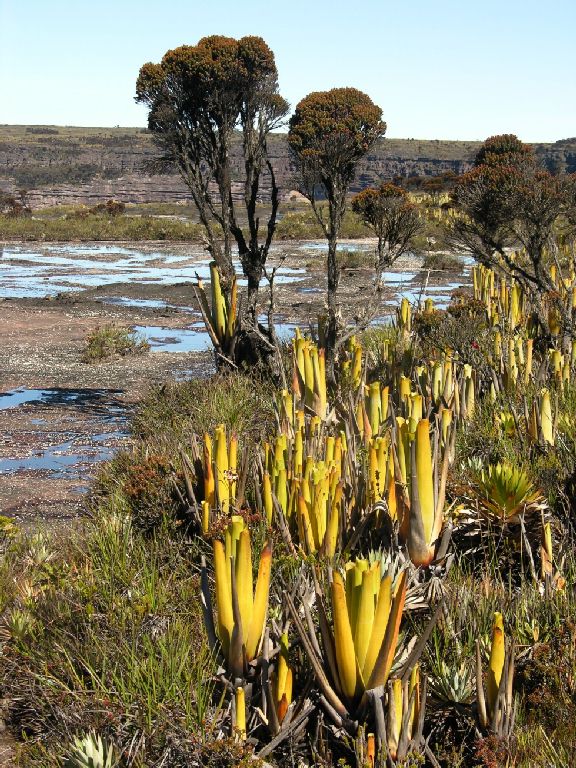
A mixed population of Brocchinia hechtioides, B. reducta and hybrids growing on the Chimantá Massif in southern Venezuela
{McPherson, Stewart (2010) In: Carnivorous Plants and Their Habitats, p. 694, Redfern Natural History} Production, Dorset, England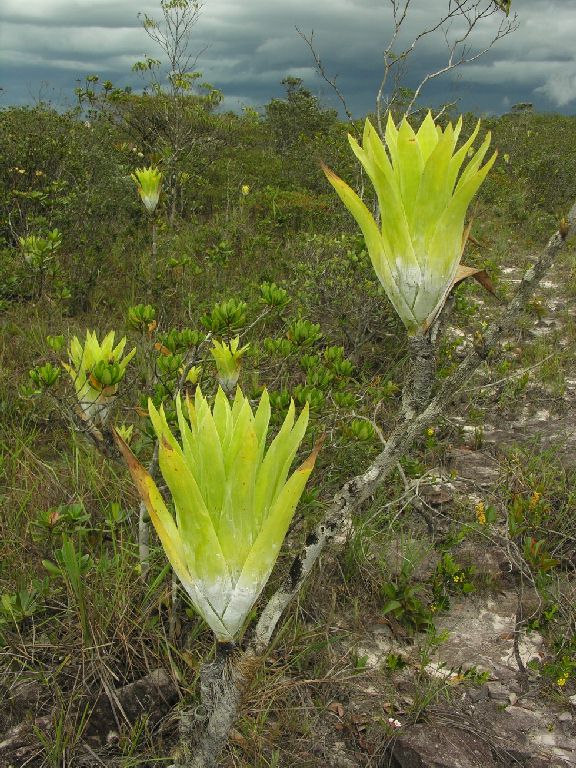 . . . .
. . . . 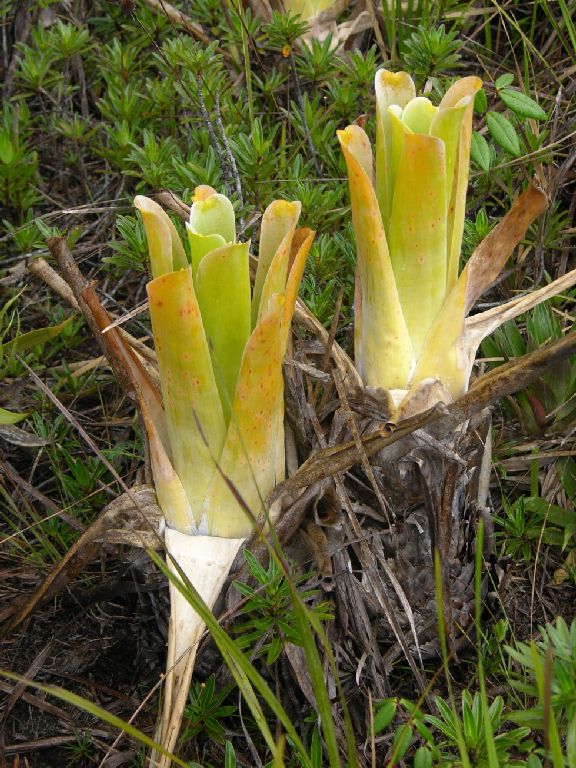
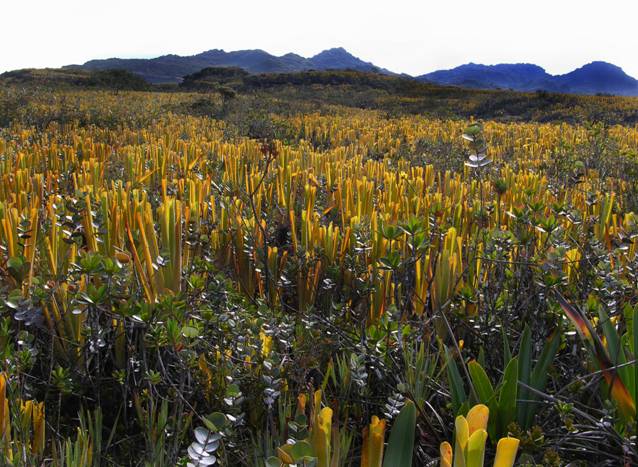
A golden landscape of Brocchinia hechtioides in the Guiana Highlands
{McPherson, Stewart (2007) In: Pitcher Plants of the Americas, p. 46, The McDonald & Woodward Publishing Company, Blacksburg, Virginia}
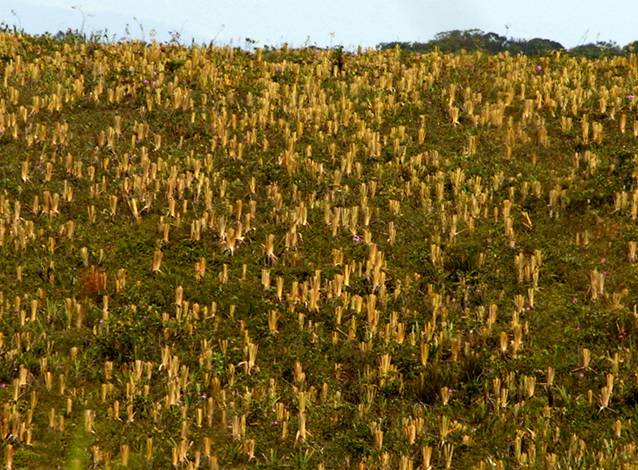
BROCCHINIA Schultes f. (brock-in’ea)* (Sub-family Pitcairnioideae)
{* Padilla, Victoria. In: Bromeliads – A Descriptive Listing of the Various Genera and the Species Most Often Found in Cultivation, Crown Publishers, Inc., New York }
(Named to honour Giovanni Battista Brocchi (1772-1826) an Italian student of biology and geology.)
{*Szesze, Michael, Carnivorous Plant Nursery http://www.carnivorousplantnursery.com/info/growingbromeliad.htm }
As mentioned above, Brocchinia reducta is native to the Guiana Highlands of South America where it grows as a terrestrial in the low-lying depressions and crevices among other bog plants such as ferns and horsetails in a sandy peat mix. The climate is windy, misty, foggy and cool year round, with typical daily temperatures between 8-200C, although throughout the year they can range between 1-320C. Rainfall is abundant (200-400 cm/year) and while nights are cold, and winter frosts common, it rarely freezes.
{*Padilla, Victoria. As above.}
(From the Greek word meaning “view”, probably referring to its habit of growing on trees.)
CATOPSIS BERTERONIANA (Sub-family Tillandsioideae)
Powdery-strap air plant, ‘Lantern of the Forest’
(Text by David Troxell—reprinted with permission from the Marie Selby Botanical Gardens, Sarasota, FL)
Our featured plant is an epiphytic bromeliad that is purported to be carnivorous. Catopsis berteroniana grows high up in the trees, often times in bare trees in full sun, with little opportunity to catch the falling leaves or other detritus that many bromeliads use for nutrition. When bromeliad tanks are actually dissected and studied, we have found over and over that Catopsis contains many times more non-aquatic insects than the average bromeliad. This fact, combined with the chalky powder which coats the underside of the leaves and the plant’s habit of living so high and exposed in the canopy, have led to the popular theory that this is an actively insectivorous plant.
TILLANDSIA USNEIOIDES
(A reply from Chris Larson {of the Victorian Bromeliad Society} at a Tillandsia discussion group, in answer to a query regarding the growing of T. usneoides in Townsville)
Spanish moss is a wonderful plant in all of its forms. Peter Tristram and I have been collecting from many sources overseas and some of these are now reaching a good size. However, I find that they all like approximately the same conditions in culture. It grows fastest when grown in a humid house, with good ventilation to stop the centre from staying wet for too long. In Melbourne conditions a strong wind will dry it out a little too much due to our dry summer heat. Fertilizer helps immensely.
FAMILY PSEUDOCOCCIDAE
UNARMOURED SCALE PESTS OF BROMELIADS – MEALYBUGS
(Reprinted from the January 2014 Newsletter of the Far North Coast Bromeliad Study Group)
1) Coarse river sand (Tabulam sand)
2) Diatomaceous earth (agricultural grade)
By Les Higgins 2014 (Reprinted from January 2014 Newsletter of the Far North Coast Bromeliad Study Group)
VALE - HETTY KERSTHOLT
It is with a great deal of sadness that I report that Hetty Kerstholt died in early November last. Hetty and her daughter, Carol, joined our Society in May 2011 and we have enjoyed their company at our monthly meetings and other events since.